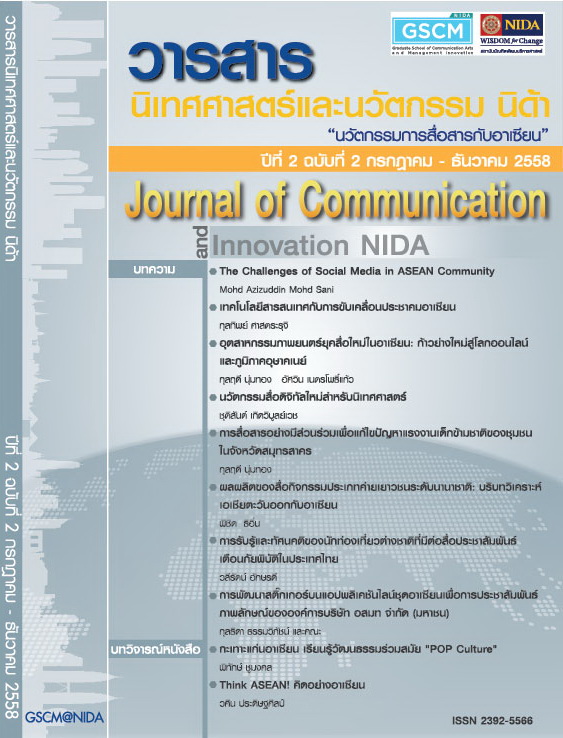การสื่อสารอย่างมีส่วนร่วมเพื่อสร้างความตระหนักรู้สิทธิขั้นพื้นฐาน ของแรงงานเด็กข้ามชาติในชุมชนจังหวัดสมุทรสาคร
Main Article Content
Abstract
การวิจัยครั้งนี้มีวัตถุประสงค์เพื่อศึกษาการสื่อสารอย่างมีส่วนร่วมเพื่อสร้างความตระหนักรู้สิทธิขั้นพื้นฐานของแรงงานเด็กข้ามชาติในชุมชนจังหวัดสมุทรสาคร โดยเป็นการวิจัยเชิงปฏิบัติการ (Action Research) โดยสร้างช่องทางการสื่อสารอย่างมีส่วนร่วมให้กับชุมชนแรงงานข้ามชาติ อำเภอเมือง จังหวัดสมุทรสาคร ซึ่งเป็นพื้นที่ที่มีจำนวนแรงงานข้ามชาติมากที่สุด เป็นพื้นที่เสี่ยงและมีปัญหาการใช้แรงงานเด็กข้ามชาติ
ผลการวิจัยมีดังนี้
- รูปแบบการสื่อสารอย่างมีส่วนร่วมเพื่อสร้างความตระหนักรู้สิทธิขั้นพื้นฐานของแรงงานเด็กข้ามชาติในชุมชนจังหวัดสมุทรสาคร ก่อนที่ผู้วิจัยจะเสริมศักยภาพการสื่อสารอย่างมีส่วนร่วม พบว่า มีรูปแบบการสื่อสารที่มีทิศทางการสื่อสารแบบทางเดียว (One-way Communication) มีการไหลของข้อมูลข่าวสารแบบบนลงล่าง (Top-down Communication) ที่เป็นการสื่อสารแบบแนวตั้ง (Vertical Communication) โดยที่ผ่านมาเจ้าหน้าที่จากมูลนิธิเครือข่ายส่งเสริมคุณภาพชีวิตแรงงาน จะมีบทบาทเป็นผู้ส่งสาร (Sender) ทำให้ส่วนใหญ่มีการไหลของข้อมูลข่าวสารจากภายนอกสู่ภายในชุมชน และคนในชุมชนส่วนใหญ่มีบทบาทเป็นผู้รับสาร (Receiver) ซึ่งเป็นระดับต่ำสุดของการมีส่วนร่วม แบบรับ (Passive)มีเพียงส่วนน้อยที่ทำหน้าที่เป็นผู้ส่งสาร ซึ่งชาวบ้านที่เป็นผู้ส่งสารนั้นมักจะได้รับการมอบหมายจากผู้นำชุมชนมาอีกที เกี่ยวกับเรื่องการจัดกิจกรรมภายในชุมชน โดยนิยมสื่อสารด้วยวาจา
- จากการศึกษาพบว่าแรงงานข้ามชาติในชุมชนจังหวัดสมุทรสาครมีปัจจัยสนับสนุนและปัจจัยอุปสรรค ดังนี้ (1) ปัจจัยด้านลักษณะทางเศรษฐกิจ พบว่าคนในชุมชนมีอุปสรรคด้านงานที่ทำ เวลา และรายได้ของครอบครัว (2) ปัจจัยด้านการสื่อสาร พบว่าจุดเด่นของคนในชุมชนคือ การยอมรับฟังความคิดเห็นของผู้อื่น และเปิดใจรับตัวกลางภายนอกเข้าไปร่วมพัฒนา แต่อุปสรรคคือ ปัญหาการสื่อสารที่ไม่เข้าใจ ขาดช่องทางการสื่อสาร และคนในชุมชนขาดการมีส่วนร่วมในการสื่อสาร (3) ปัจจัยด้านวัฒนธรรมและสังคม พบว่าในสภาพชุมชนแออัด แต่คนในชุมชนกลับมีความสัมพันธ์ที่แน่นแฟ้น ประกอบกับผู้นำชุมชนเข้มแข็ง แต่ในทางกลับกันยังคงมีช่องว่างของทัศนคติระหว่างคนไทยและแรงงานข้ามชาติอยู่ (4) ปัจจัยด้านนโยบาย นายจ้าง และรัฐบาล พบปัจจัยสนับสนุนคือ ความต้องการรับรู้สิทธิขั้นพื้นฐาน แต่ยังคงมีอุปสรรคคือความเกรงกลัวนายจ้างและเจ้าหน้าที่ของรัฐ
- ในการเสริมศักยภาพการสื่อสารอย่างมีส่วนร่วมให้กับชุมชน ได้มุ่งการเปลี่ยนบทบาททางการสื่อสาร จากผู้รับสารแบบรับ (Passive)เป็นผู้รับสารแบบรุก (Active) เปลี่ยนจาก “ผู้รับสาร” เป็น “ผู้ส่งสาร” การปรับเปลี่ยนทิศทางการสื่อสาร “แบบทางเดียว” เป็น “แบบสองทาง” การปรับเปลี่ยนการไหลข้อมูลข่าวสารจาก “บนลงล่าง” เป็น “ล่างขึ้นบน” ปรับเปลี่ยนการไหลข้อมูลข่าวสารจาก “แนวตั้ง” เป็น “แนวนอน” โดยผู้วิจัยได้เลือกกลยุทธ์การสื่อสาร ได้แก่ การจัดประชุม การจัดอบรมสิทธิของแรงงานเด็กข้ามชาติ การสร้างสื่อชุมชน และการมอบสื่อ
- ผลจากการเสริมศักยภาพการสื่อสารชุมชนด้วยกลยุทธ์การสื่อสารอย่างมีส่วนร่วมแล้ว ทำให้รูปแบบการสื่อสารของคนในชุมชนเปลี่ยนแปลงไปสู่การมีส่วนร่วม ทั้งในด้านบทบาทการสื่อสาร ทิศทางการสื่อสาร การไหลของข้อมูลข่าวสาร ซึ่งจากการสื่อสารอย่างมีส่วนร่วมภายในชุมชน ส่งผลให้นายจ้างและองค์กรต่าง ๆ มีปฏิกิริยาตอบกลับ เช่น การส่งเสริมให้เด็กข้ามชาติได้มีโอกาสเรียนหนังสือ และได้สร้างศูนย์การเรียนรู้เพื่อเปิดโอกาสให้เด็กข้ามชาติได้เข้ามาศึกษาร่วมกับนักเรียนไทย รวมถึงเป็นการลดช่องว่างความแตกต่างระหว่างเชื้อชาติไปในทางที่ดีขึ้นอีกด้วย
The objective is to study the participating communication to aware of the fundamental rights of the migrant in the communities in Samutsakorn province. This study is the Action research by creating the participating in channel of communication with the migrant labor communities in Meuang district, Samutsakhon Province where there is the highest of the migrant labor in Thailand and the risk area that it has the problem of migrant children labor.
The results of research
1. The pattern of participating communication for solving the migrant children labor in Samutsakorn. Before the researcher will increase the potential of participating communication, finding that there is the pattern of One-way Communication flowing the information in the way of Top-down communication that is the vertical communication. In the part, the authorities of Labor Rights Promotion Network is as the sender so the major of information flows from outside to inside communities and most people in communities is as the receiver that is the lowest level of Passive participance, there is less people who is as the sender by saying that is the most popular way to communicate.
2. From result of case study can find that the migrant labor in Samutsakorn province had support factors and problem factors as follows, First factor: Factor from economic situations that can find people in community had problem with their job responsibility, time and their income. Second factor : Factor from communicate with other, however we can found good result was people in community was listen to the opinions of others and people can accept outside factor to make their community develop but their problem was miscommunication, misunderstand and lack participate to communicate. Third factor: Factor from culture and social although they had crowed community environment but people had strong relationship also they had strong leader who had powerful to make people give participate in the communication process. But we can find problem factor from the gap contrast of attitude of Thai people and migrant labor. Forth factor: Factor of government policy about the employer. The support reason was migrant labor’s lack of knowledge about their fundamental rights and action on afraid of their employer and government authorities.
3. For increasing the potential of participating communication, it changes the communication role from “the passive receiver” to “the active receiver”, from “the receiver” to the sender, the way of communication from “one-way communication” to “two-way communication”, changing the information flowing from “top-down communication” to “down-top communication” ,changing from “the vertical communication” to “the horizon communication” that the researcher decides to use the communicating strategies such as the meeting , the seminar of migrant children rights, making communities media and giving media.
4. The result of increasing the potential of communities communication by participating communication strategies is change to participating communication pattern of people in communities including the role of communication, the way of communication, the flowing communication that these affect the employer and other organization to have responded to this changing such as increasing education to the migrant children and building the learning center to learn with that students including to reduce the gap between the nationalities in the better way.
Article Details
ข้อความและความเห็นในวารสารนิเทศศาสตร์และนวัตกรรม นิด้า เป็นของผู้เขียนแต่ละท่าน มิใช่ของคณะนิเทศศาสตร์และนวัตกรรมการจัดการ สถาบันบัณฑิตพัฒนบริหารศาสตร์


